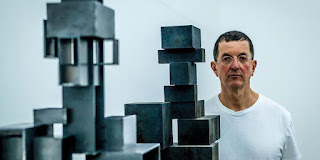In the book I just finished reading, the sixth of Ann Cleeves's Shetland mysteries (and which I will comment on shortly), there is a mention of a British sculptor that intrigued me enough to look him up. The passage in question takes place near the end of the book, when the chief inspector is searching for a missing woman, on a beach. In the foggy near distance, she hears sobbing, and sees a spectral figure.
Then, like a curtain rising, the mist ahead of her cleared and she saw the figure clearly, still some way off to the north of her and on the part of the beach that was closest to the Meoness community hall. The water had already come up to the figure's calves. Willow was reminded of a series of sculptures that she and her mother had visited on a beach in Merseyside. Antony Gormley's cast-iron figures, which had been moulded from his own body, planted in the sand and covered twice a day by the tide. Each of them had seemed entirely lonely as the water covered them, and Willow had watched, fascinated, as they disappeared a little at a time under the sea.
Here are the sculptures alluded to here, a project titled Another Place, installed on Crosby Beach near Liverpool:
"Gormley’s most iconic work," according to this article from HERO, "is the 20m high Corten steel Angel of the North in Gateshead, completed in 1998 as a monument to post-industrial Britain. It is so popular it has become an emblem for the UK, featuring in the new British passports or greeting visitors at Heathrow on giant posters."
Here are some more of his pieces (the first entry being a video narrated by Gormley himself):
 |
| Here is a story to go with this 2020 piece |
I would include links to articles about him, but they are so numerous that I will just suggest: if you want to read more about him, including seeing various lists of his 5, 10, 11, etc. "most iconic" creations, just Google him. I'm shocked I'd never heard of him before, he's so famous.












No comments:
Post a Comment